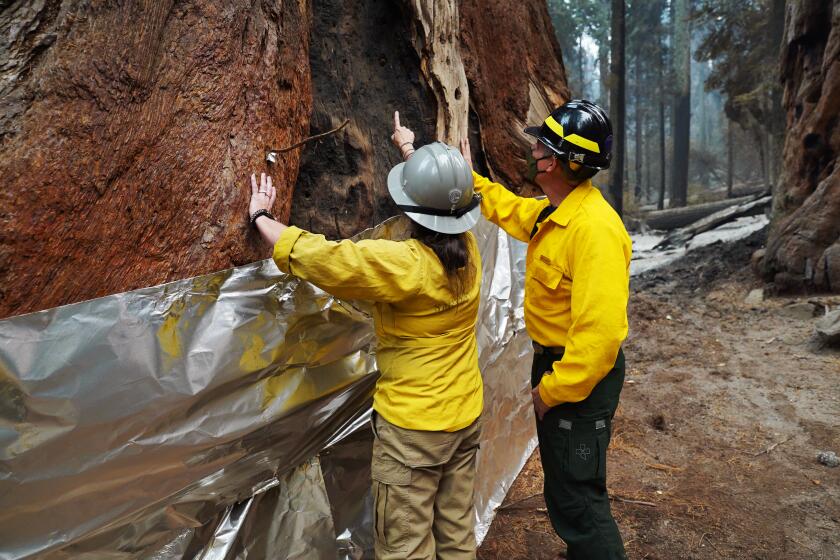Near fire-scorched sequoia groves, up to 10,000 trees to be removed along highway

- Share via
THREE RIVERS, Calif. — In the wake of California wildfires, upward of 10,000 trees weakened by fires, drought, disease or age must be removed, work that will keep a nearby highway closed to visitors who seek to see the world’s two largest sequoia trees.
The hazard trees could potentially fall onto people and cars on the section of State Route 180 known as Generals Highway, or they could create barriers for emergency and fire response, the Sequoia and Kings Canyon National Parks said Friday.
For the record:
11:18 a.m. Oct. 25, 2021A previous version of this story incorrectly stated that up to 10,000 sequoia trees would need to be removed. That figure, however, represents all hazard trees that must be removed, not only sequoias.
The highway is closed due to the KNP Complex blaze, which was 60% contained after burning 138 square miles of forest and will remain blocked off to visitors while crews cut down trees and trim branches. Cooler weather has helped slow the flames, and the area was expected to see rain starting Sunday.
The highway connects Giant Forest, home to the General Sherman Tree, which is considered the world’s largest by volume, and Grant Grove, home to the General Grant Tree, the second-largest tree in the world. The trees along the highway include sequoias, pine and conifer trees, fire spokeswoman Kimberly Caschalk said.
The KNP Complex has been burning since Sept. 9, when lightning ignited two fires that later merged.
The KNP Complex fire may have killed hundreds of sequoia trees in the southern Sierra, and at least 74 have died in the Windy fire, officials said.
Forest officials said earlier this month the fires may have killed hundreds of giant sequoias, but the full extent of the damage has not been determined.
The fire’s effect on giant sequoia groves was mixed. Most were exposed to low- to medium-intensity fire behavior that the sequoias have evolved to survive, and the most notable trees survived.
Firefighters took extraordinary measures to protect the sequoias by wrapping fire-resistant material around the bases of some giants, raking and clearing vegetation around them, installing sprinklers and dousing some with water or fire retardant gel.
On Friday, forest staff unwrapped the base of the General Sherman tree after danger from the fire had passed.
“We’re confident that tree is relatively safe,” Caschalk said.
In California and beyond, some people are deeply in grief, stunned that flames could again imperil some of Earth’s oldest living things.
Drought in the West tied to climate change is making wildfires harder to fight. Scientists say climate change has made the region much warmer and drier over the last 30 years — meaning the rain and snow that does fall will probably evaporate or absorb into the soil — and will continue to make weather more extreme and wildfires more frequent and destructive.
Recent storms have helped contain some of the nation’s largest wildfires this year, including one that threatened the popular Lake Tahoe resort region this summer and is now 100% contained after snow blanketed the western side of the blaze and rain dropped on the eastern side. But this week’s storms won’t end the drought plaguing California and the western United States.





